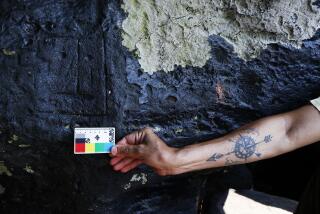Finding History Doses in Indian Petroglyphs
- Share via
CORRALES, N.M. — One is shaped like a parrot, another is a caricature of a human face.
Still another gleams demonlike in the hot afternoon sun, taunting modern man to fathom the mystery of these Indian versions of Egypt’s hieroglyphics.
Chipped many hundreds of years ago into black lava boulders at the foot of five extinct volcanoes, they lie in stony silence at Indian Petroglyph State Park, just 10 miles south of here and only a snake’s rattle from the city limits of Albuquerque.
American travelers in Europe, awed by the centuries-old history of that continent and embarrassed by the “newness” of their own, need only come to this charming little Southwest town for a double dose of history as potent as any abroad.
1,200-Room Pueblo
The second half of the Corrales “daily double,” easily completed in one afternoon of sightseeing, is Coronado State Monument 10 miles north of town, where spectacular ruins of a 1,200-room, 14th-Century Tiwa Indian pueblo spread over the sands like a giant honeycomb.
There along the Rio Grande, which has slowed to a trickle after its torrential beginnings north of Taos and the Colorado line, the Tiwas held open house in 1540 for Francisco Vasquez de Coronado, who had led a Spanish expedition into New Mexico in a quixotic search for gold.
Today’s explorer, escorted by lizards and cottontails scurrying amid the mesquite, and with the 10,000-foot Sandia Mountains rising across the river, searches for the riches of history among the crumbling adobe foundations and walls of the pueblo.
You can climb a ladder down into a restored ceremonial kiva, the ancients’ underground version of a men’s-only meeting hall. In this kiva, one of several excavated in the 1930s, diggers found a nearly intact set of multicolored murals on 17 successive layers of wall plaster.
The murals, which depict human and animal forms, are considered among the finest examples of prehistoric mural art in North America.
Far less complex in execution, but far more mysterious, are the childlike drawings at Indian Petroglyph State Park. Four walking tours range from easy to moderately difficult.
Hundreds of Glyphs
An estimated 15,000 images are etched into the cliff face, tumbled boulders and hidden canyons of the park.
Legal steps have been taken. Remove a petroglyph rock from its original resting place now, and you do so at your own risk.
Indian Petroglyph State Park is open every day of the year. Hours: 8 a.m. to 6 p.m., Memorial Day through Labor Day; 8 a.m. to 5 p.m. the rest of the year. Fee: $1 per vehicle.
Coronado State Monument, open 9 a.m. to 5 p.m. daily. Closed state and national holidays. Fee: $1 for adults, 50 cents for children 7 to 18.
For more information and free brochures on these and other Corrales/Albuquerque area attractions, write to the Albuquerque Convention and Visitors Bureau, P.O. Box 26866, Albuquerque, N.M. 87125, or call toll-free (800) 284-2282.
More to Read
Sign up for The Wild
We’ll help you find the best places to hike, bike and run, as well as the perfect silent spots for meditation and yoga.
You may occasionally receive promotional content from the Los Angeles Times.






